PR
X
Keyword Search
▼キーワード検索
Comments
続日本100名城東北の…
New!
オジン0523さん
【甥のステント挿入… New!
Gママさん
New!
Gママさん
2025年版・岡山大学… New!
隠居人はせじぃさん
New!
隠居人はせじぃさん
ムベの実を開くコツ… noahnoahnoahさん
noahnoahnoahさん
エコハウスにようこそ ecologicianさん
【甥のステント挿入…
 New!
Gママさん
New!
Gママさん2025年版・岡山大学…
 New!
隠居人はせじぃさん
New!
隠居人はせじぃさんムベの実を開くコツ…
 noahnoahnoahさん
noahnoahnoahさんエコハウスにようこそ ecologicianさん
Calendar
カテゴリ: 海外旅行
Christ Church Cathedral・クライストチャーチ大聖堂
を後にして、東方向に歩く。
ダブリン城(Dublin Castle) の敷地内、アッパー・ヤード(Upper Yard) の入り口にある
石造りの門が現れた。
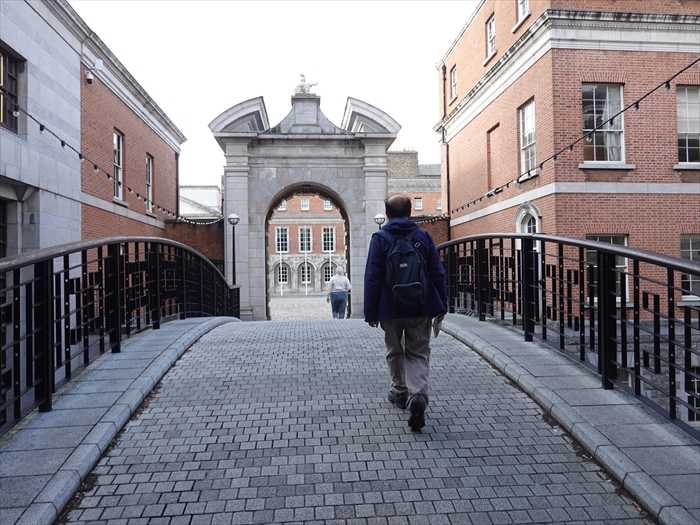
ダブリン城(Dublin Castle)内の 中庭(Upper Yard)に入る石造アーチ門と橋.
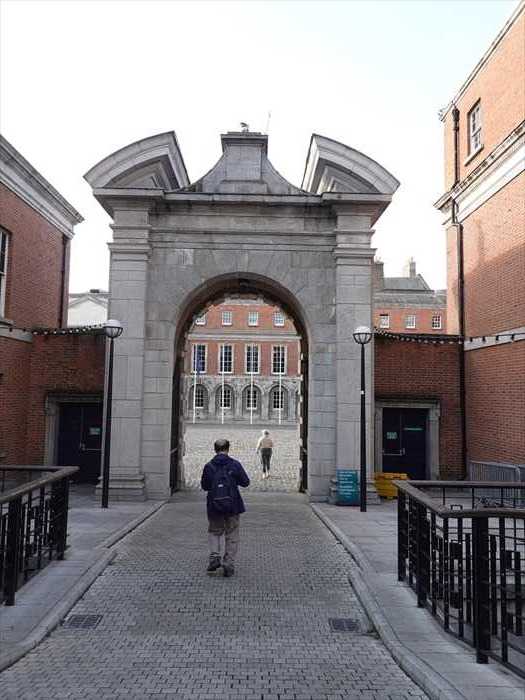
ダブリン城(Dublin Castle)の 配置案内図 。
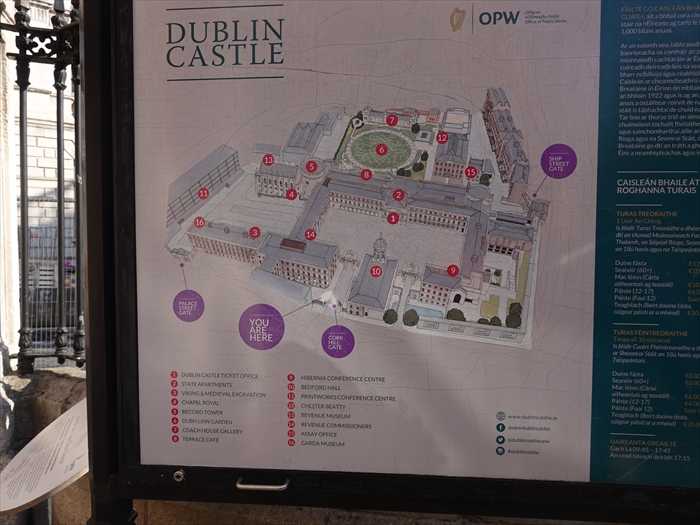
近づいて。
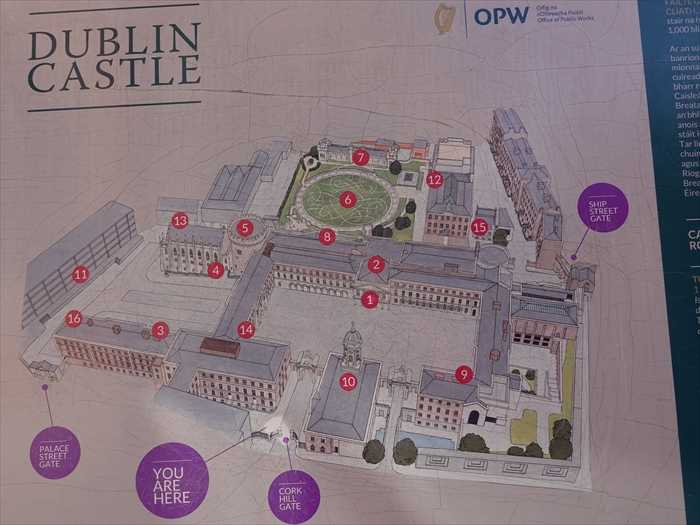
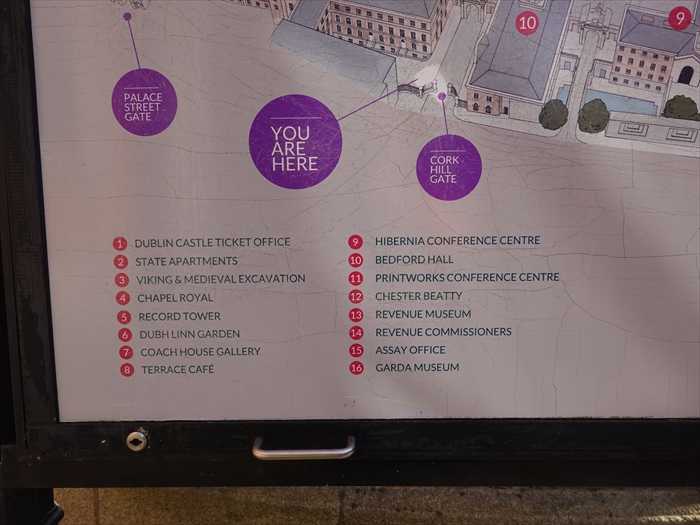
ダブリン城(Dublin Castle)内の「 アッパー・ヤード(Upper Yard) 」と呼ばれる 中庭の様子
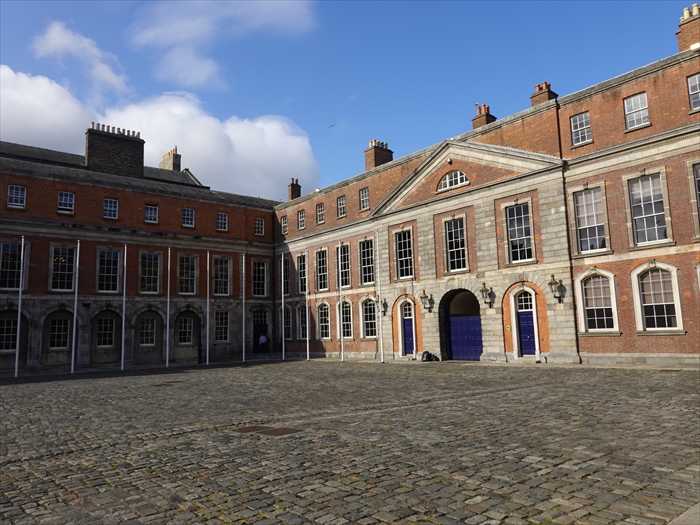
「 アーチ門 」と「 八角形の時計塔付き建物・Bedford Tower(ベッドフォード・タワー) 」。
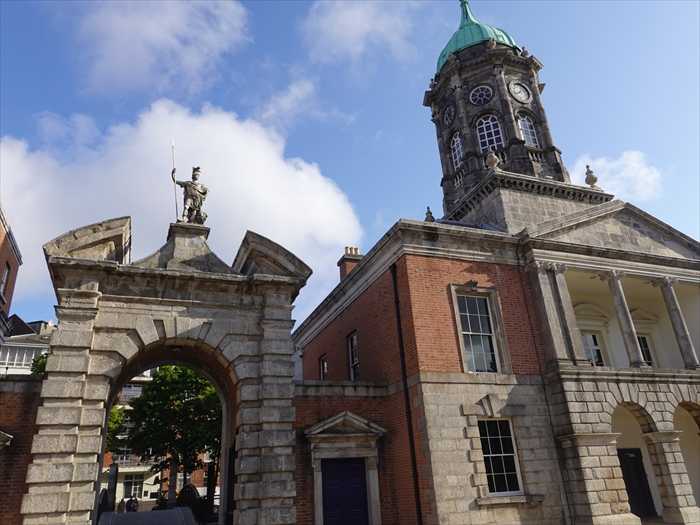
ダブリン城(Dublin Castle)内の「 アーチ門(Main Gate/Civic Sword Gate) 」を
北側(中庭側)から南方向に見る 。
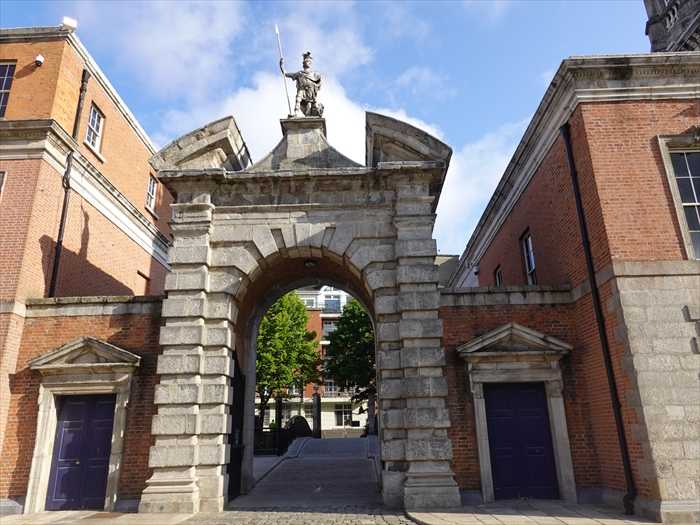
通称: 「Civic Sword」像 。
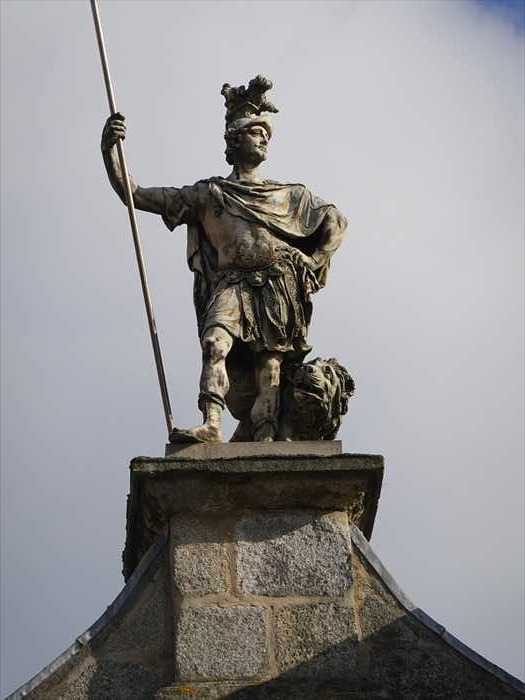
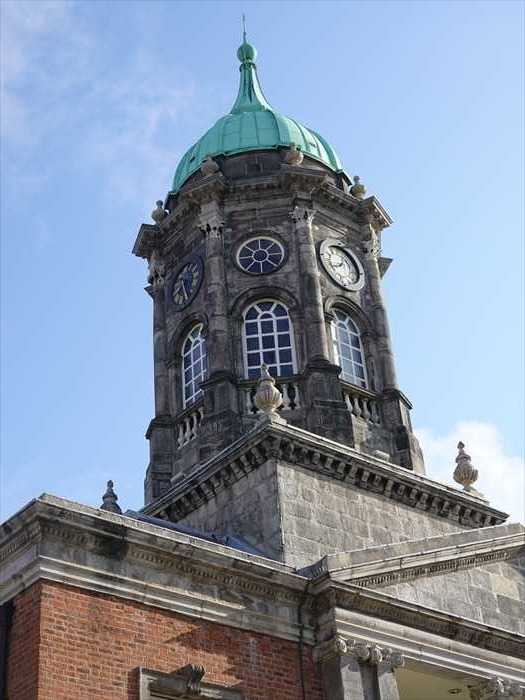
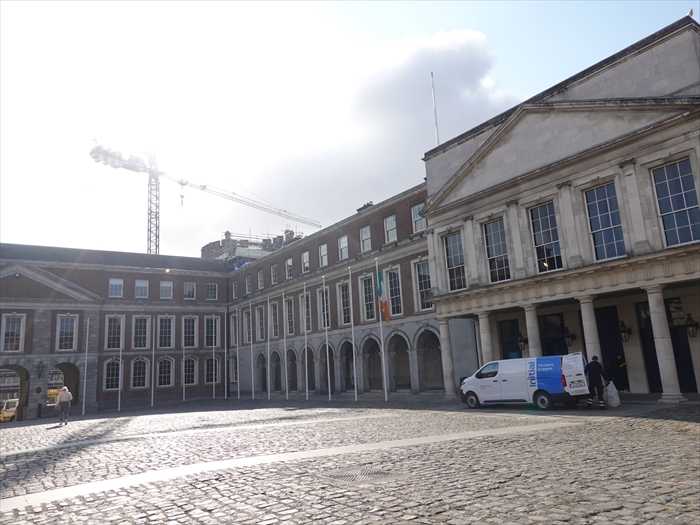
こちらは「 パレス・ストリート門(Palace Street Gate) 」

ズームして。

このポスターは、犯人検挙のために発行されたもので、当時の懸賞金£1,000は非常に高額
(現在の貨幣価値で約13万ポンド=約2,600万円以上)に相当
この案内板は、 Bedford Tower(ベッドフォード塔)に関する情報 を伝えていた。
【ダブリン首都警察
ベッドフォード・タワー(1761年建造)
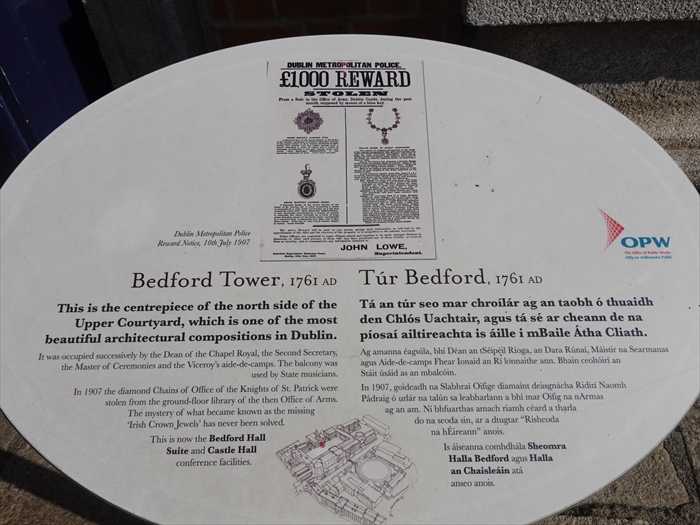
チャペル・ロイヤル(Chapel Royal) 」。
ダブリン城構内に位置する、19世紀初頭・1814年に建てられた 英国国教会様式の礼拝堂 。
チャペル・ロイヤルは、ベッドフォード・タワー(Bedford Tower)やステート・アパートメント
と並び、アッパー・ヤード(Upper Courtyard)を構成する代表的建築のひとつ。
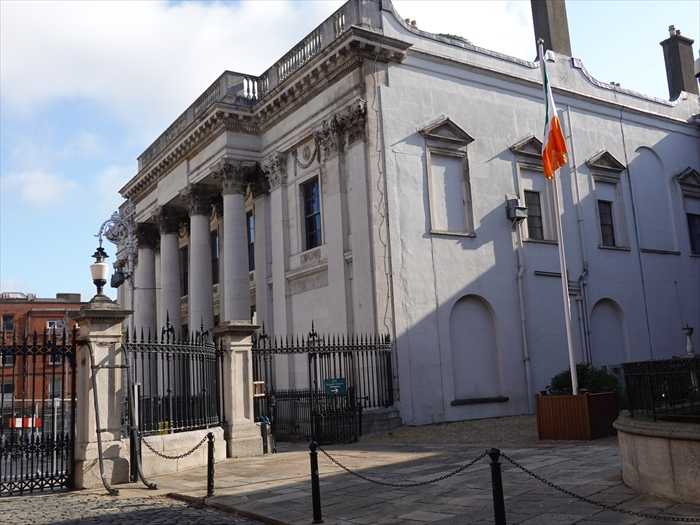
ダブリン城の北東側に位置する Cork Hill Gate(コーク・ヒル門) を外側から。
外へ出るとすぐに Dublin City Hall(ダブリン市庁舎 ) や Lord Edward Street に通じていた。
「Cork Hill Gate」と「Civic Sword Gate」は、場所は同一ですが、呼び名や意味合いが時代や
文脈によって異なるのだと。
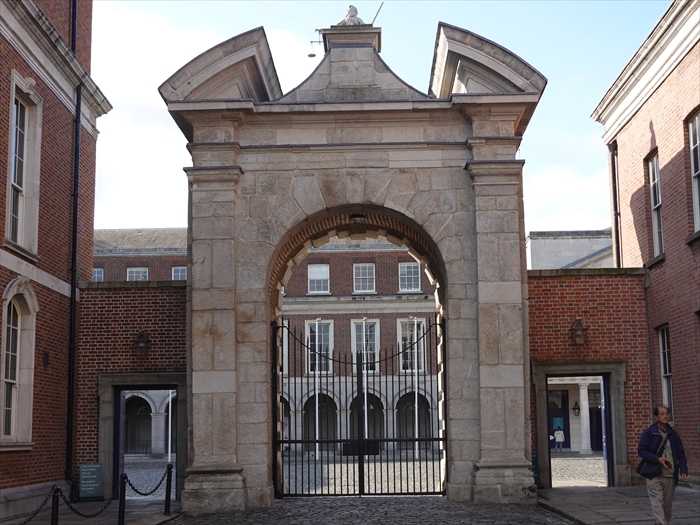
この案内板は、ダブリン城(Dublin Castle)の見学ツアーに関する情報、料金を示していた。
「 WELCOME TO DUBLIN CASTLE,
to the magnificent Chapel Royal and State Apartments, from British rule to
Irish independence and beyond.」
【 ダブリン城へようこそ
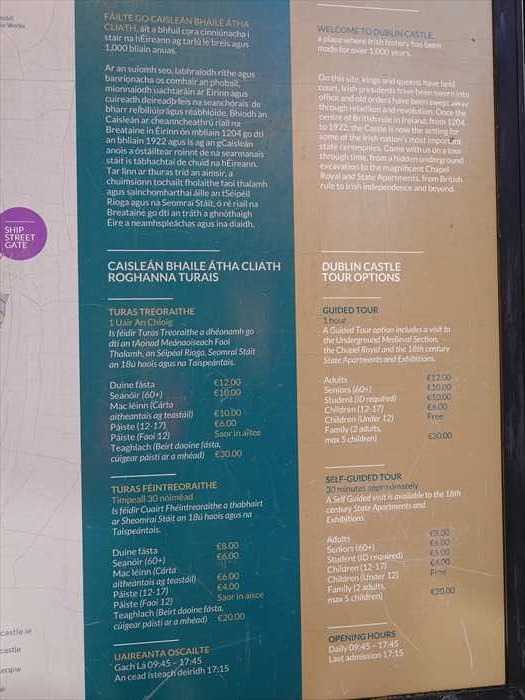
ダブリン城(Dublin Castle)の 「State Apartments(国家の間)」の正面玄関


「 Welcome
and then self-guide through the State Apartments. (Full Price Ticket applies)」
The rest is omitted
OPENING HOURS
Daily: 09:45 – 17:45
Last admission: 17:15】
【 ようこそ
ステート・アパートメントを見学することも可能です(この場合もフルチケット料金が
適用されます)】
途中 略
・開館時間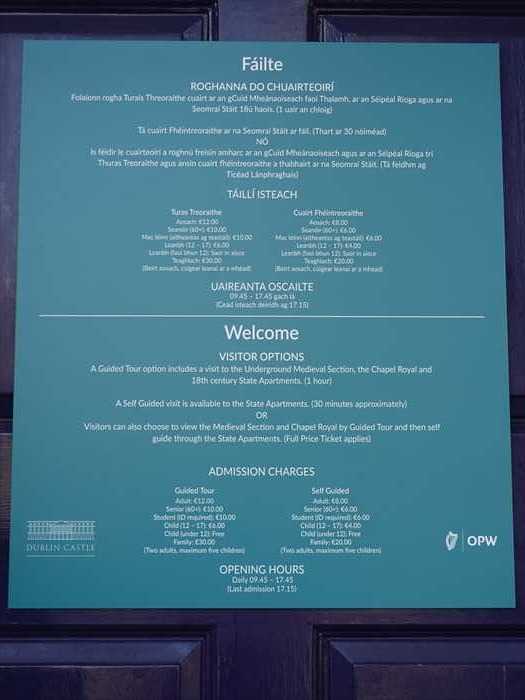
「The State Apartments
1680–1830 AD
Formerly the residential and ceremonial quarters of the Viceroys (Deputies of the British Monarch) and the Viceregal Court, and the focus of fashionable social life, they are now
the most important ceremonial rooms in Ireland.
The State Apartments include the former State Bedrooms, the Drawing and Throne
Rooms, the Portrait Gallery, St. Patrick’s Hall and George’s Hall.
St. Patrick’s Hall, the venue for prestigious State functions, including the inauguration of
the Irish President, was last used for such by British monarchs in 1911.Upon her first state visit to Ireland, Queen Elizabeth II spoke in St. Patrick’s Hall in 2011.」
【ス テート・アパートメント(国家公式室)
スピーチを行いました。】
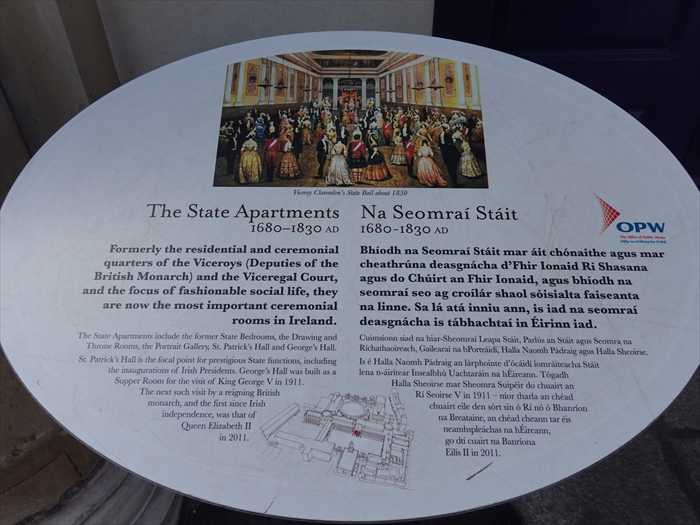
「 クロック・タワー(Clock Tower) 」を中心とした
「ベッドフォード・タワー(Bedford Tower) 」
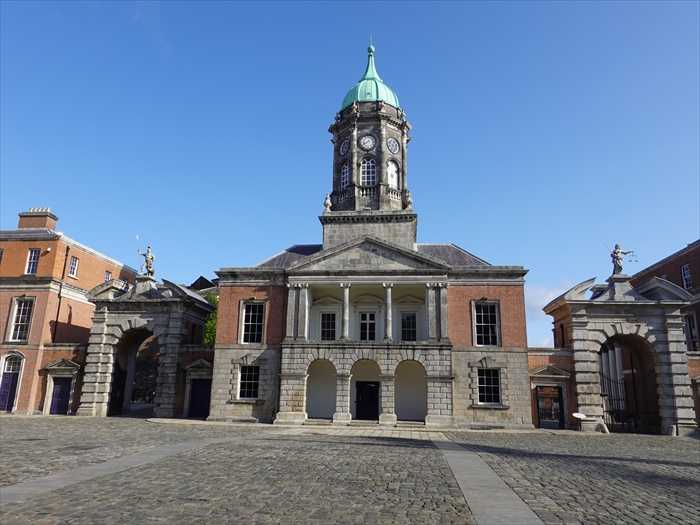
ダブリン城(Dublin Castle) の敷地内、アッパー・ヤード(Upper Yard) の入り口にある
石造りの門が現れた。
ダブリン城は13世紀初頭(1204年頃)、イングランド王ジョンの命で建設が始まった
。
城は防衛拠点として機能するため、四方に高い石壁と堀(moat)が巡らされていた。
この堀は、ポドル川(River Poddle)の流れを取り込み、水堀(水のある堀)として利用されて
いた。実際、ポドル川は現在も地下を流れており、城の下を通過しているのだ と。
この太鼓橋の下は現在埋め立てられているが、元々は堀や防衛溝が存在していた空間である と。
いた。実際、ポドル川は現在も地下を流れており、城の下を通過しているのだ と。
この太鼓橋の下は現在埋め立てられているが、元々は堀や防衛溝が存在していた空間である と。

ダブリン城(Dublin Castle)内の 中庭(Upper Yard)に入る石造アーチ門と橋.
石造アーチ門は、Upper Yard(アッパー・ヤード)と呼ばれる中庭への主要な出入口の1つ。

ダブリン城(Dublin Castle)の 配置案内図 。

近づいて。

1Dublin Castle Ticket Officeチケット売場(入口案内所)
2State Apartments国家行事用の部屋群(一般見学可)
3Viking & Medieval Excavationヴァイキングと中世遺構の展示エリア
4Chapel Royal礼拝堂(歴代総督の使用)
5Record Tower城で最も古い塔(13世紀)
6Dubh Linn Garden城裏手の公園エリア
7Coach House Galleryアートギャラリー(展示あり)
8Terrace Caféカフェスペース
9Hibernia Conference Centreハイバーニア会議センター
(会議や公式イベントに使用される施設)
10Bedford Hallベッドフォード・ホール
(かつてのバンケット会場、現在も多目的に使用)
11Printworks Conference Centreプリントワークス会議センター
(大規模イベントや展示会、会議等に対応)
12Chester Beattyチェスター・ビーティ図書館・美術館
(貴重な写本・東西の美術コレクションを所蔵)
13Revenue Museum税務博物館(Revenue Museum)
(アイルランドの税制の歴史を紹介)
14Revenue Commissioners税務当局(国税庁本部の一部)
(事務所棟)
15Assay Office貴金属検査局(アッセイ・オフィス)
(金・銀などの純度を検査・認定)
16Garda Museumガルダ博物館(警察博物館)
(アイルランド警察の歴史・資料を展示)

ダブリン城(Dublin Castle)内の「 アッパー・ヤード(Upper Yard) 」と呼ばれる 中庭の様子
写真に見えるのは 「アーチ門(Main Archway)」の内側から見た建物
中庭を囲むこの一連の建物群は、18世紀以降に整備されたジョージ王朝様式の公共建築であり、
左側の建物は旧軍事用途、右側の建物はかつての「副王(Lord Lieutenant)」の公邸や政庁部門
であった。
であった。

「 アーチ門 」と「 八角形の時計塔付き建物・Bedford Tower(ベッドフォード・タワー) 」。

ダブリン城(Dublin Castle)内の「 アーチ門(Main Gate/Civic Sword Gate) 」を
北側(中庭側)から南方向に見る 。
この門は、 Upper Yard(アッパー・ヤード)と外部をつなぐ主門
であり、通常「 Main Gate
」
または「 Civic Sword Gate 」と呼ばれている と。
頂上には 剣を掲げた人物像 が立っていた。
または「 Civic Sword Gate 」と呼ばれている と。
頂上には 剣を掲げた人物像 が立っていた。

通称: 「Civic Sword」像 。
この像は、明確な歴史的人物ではなく、市民権・統治権の象徴(Civic Authority)としての
擬人像 と考えられている と。
擬人像 と考えられている と。
主に以下の特徴があるのだと:
右手に掲げた長い剣(または槍)
:「市民の権利と統治の正当性」を象徴(剣に見えるが、
直線的な棒状で槍とも解釈可能)
直線的な棒状で槍とも解釈可能)
軍装風の服装:
古代ローマ風の軍装スタイル(市民の守護者、都市の防衛)
足元のライオンの頭: 「勇気」「権威」「支配力」の象徴。しばしば国家や権力の
象徴として用いられる
足元のライオンの頭: 「勇気」「権威」「支配力」の象徴。しばしば国家や権力の
象徴として用いられる
頭部の羽根付き兜:
戦士・防衛者の姿を表す(ローマ兵のヘルメット風)
設置場所:
旧城門の上、通行者の頭上に立ち、都市と城の「守護者」を
象徴する役割
象徴する役割

ダブリン城(Dublin Castle)の中心的構造物のひとつ、
「 Bedford Tower(ベッドフォード塔/ベッドフォード・タワー) 」。
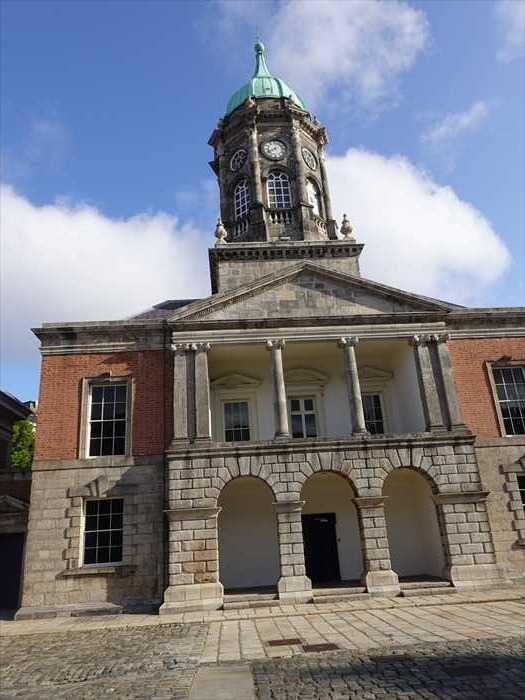
建設時期: 1750年代 (ジョージアン時代)
「 Bedford Tower(ベッドフォード塔/ベッドフォード・タワー) 」。

建設時期: 1750年代 (ジョージアン時代)
建築様式:
ジョージアン様式+ロココ的装飾を一部含む
構造:
八角形の塔身に銅葺きのドーム屋根(緑青により緑色)
役割:
18世紀当初:城の兵器庫(Armoury)の一部
現在は儀礼的シンボル塔として保存・公開
時計: 東西南北四方に時計文字盤を配置、視認性を高めている
時計: 東西南北四方に時計文字盤を配置、視認性を高めている

・右手前(白い三角破風の建物)
:
State Apartments(ステート・アパートメンツ)の入口がある建物。
かつては貴族や賓客を迎えるレセプション・エリアとして使用された。現在は博物館施設。
・右側中央(国旗の掲揚):
ガバメント棟(Government Buildings)一部。
国旗(アイルランド三色旗)が掲げられており、迎賓施設の一部でもある。
State Apartments(ステート・アパートメンツ)の入口がある建物。
かつては貴族や賓客を迎えるレセプション・エリアとして使用された。現在は博物館施設。
・右側中央(国旗の掲揚):
ガバメント棟(Government Buildings)一部。
国旗(アイルランド三色旗)が掲げられており、迎賓施設の一部でもある。
・左奥に伸びる建物 :
19世紀以降に再建・改修された行政系建物。同一様式のアーケードが続くことから、
ジョージアン建築の統一感が見られる。
19世紀以降に再建・改修された行政系建物。同一様式のアーケードが続くことから、
ジョージアン建築の統一感が見られる。
・背後に見える塔状の建物:
Bedford Tower(時計塔)の一部がクレーンの左下に少しだけ写っていた。
Bedford Tower(時計塔)の一部がクレーンの左下に少しだけ写っていた。

こちらは「 パレス・ストリート門(Palace Street Gate) 」
この門は「Palace Street Gate」で、ダブリン城の北東側に位置し、現在のシティ・ホール
(Dublin City Hall)近く。
門の上には、 「正義の女神(Lady Justice)」の像 が立っていた。
(Dublin City Hall)近く。
門の上には、 「正義の女神(Lady Justice)」の像 が立っていた。
上部には、 天秤と剣を持った「正義の女神(Lady Justice)」の像
が載っており、西洋では
裁判・法・秩序の象徴。
裁判・法・秩序の象徴。
他の門と異なり、この女神像は目隠しをしていない(blindfoldなし)点が特徴 と。

ズームして。
天秤(Scales): 公平さ、証拠の重さを量る
剣(Sword): 正義の厳しさ、裁きの権力
目隠し(Blindfold): 偏見のない裁き(※この像は目隠しをしていません)

このポスターは、犯人検挙のために発行されたもので、当時の懸賞金£1,000は非常に高額
(現在の貨幣価値で約13万ポンド=約2,600万円以上)に相当
この案内板は、 Bedford Tower(ベッドフォード塔)に関する情報 を伝えていた。
「 DUBLIN METROPOLITAN POLICE.
£1,000 REWARD
STOLEN
From a Safe in the Office of Arms, Dublin Castle, during the past month, supposed
by means of a false key.
Bedford Tower, 1761 AD
£1,000 REWARD
STOLEN
From a Safe in the Office of Arms, Dublin Castle, during the past month, supposed
by means of a false key.
Bedford Tower, 1761 AD
This is the centrepiece of the north side of the Upper Courtyard, which is one of the most beautiful architectural compositions in Dublin.
It was occupied successively by the Dean of the Chapel Royal, the Second Secretary,
the Master of Ceremonies and the Viceroy’s aide-de-camps. The balcony was
used by State musicians.
the Master of Ceremonies and the Viceroy’s aide-de-camps. The balcony was
used by State musicians.
In 1907 the diamond Chains of Office of the Knights of St. Patrick were stolen
from the ground-floor library of the then Office of Arms.
from the ground-floor library of the then Office of Arms.
The mystery of what became known as the missing‘Irish Crown Jewels’ has never
been solved.
been solved.
This is now the Bedford Hall Suite and Castle Hall conference facilities.
【ダブリン首都警察
懸賞金 1,000ポンド
盗難
ダブリン城内の紋章官事務所にある金庫から、過去1か月以内に盗まれた。偽の鍵を使ったと
考えられる。
考えられる。
ベッドフォード・タワー(1761年建造)
ここはアッパー・コートヤード(上の中庭)の北側の中心に位置し、ダブリンでも最も美しい
建築構成の一つとされています。
建築構成の一つとされています。
この塔は、チャペル・ロイヤル(王室礼拝堂)付きの司祭、第二書記官、儀典長、副王の副官らが
順に使用していました。バルコニーは国家音楽家たち(State musicians)が使用していた場所
でもあります。
順に使用していました。バルコニーは国家音楽家たち(State musicians)が使用していた場所
でもあります。
1907年には、聖パトリック騎士団(Knights of St. Patrick)のダイヤモンド装飾の官職
チェーンが、当時の紋章官事務所(Office of Arms)の1階図書室から盗まれました。
チェーンが、当時の紋章官事務所(Office of Arms)の1階図書室から盗まれました。
この事件は後に「アイルランドの王冠の宝石(Irish Crown Jewels)失踪事件」として知られる
ようになりましたが、いまだに解決されていません。
ようになりましたが、いまだに解決されていません。
現在は「ベッドフォード・ホール・スイート(Bedford Hall Suite)」および
「キャッスル・ホール(Castle Hall)」という会議施設として使用されています。】
「キャッスル・ホール(Castle Hall)」という会議施設として使用されています。】

チャペル・ロイヤル(Chapel Royal) 」。
ダブリン城構内に位置する、19世紀初頭・1814年に建てられた 英国国教会様式の礼拝堂 。
チャペル・ロイヤルは、ベッドフォード・タワー(Bedford Tower)やステート・アパートメント
と並び、アッパー・ヤード(Upper Courtyard)を構成する代表的建築のひとつ。

ダブリン城の北東側に位置する Cork Hill Gate(コーク・ヒル門) を外側から。
外へ出るとすぐに Dublin City Hall(ダブリン市庁舎 ) や Lord Edward Street に通じていた。
「Cork Hill Gate」と「Civic Sword Gate」は、場所は同一ですが、呼び名や意味合いが時代や
文脈によって異なるのだと。
Cork Hill Gate:
現代の公式名称城の北東側の出入口。
Cork Hill通り(市庁舎 City Hall 側)に面しています。
Cork Hill通り(市庁舎 City Hall 側)に面しています。
Civic Sword Gate:
歴史的・儀礼的文脈での名称(18〜19世紀)
ダブリン市長が「市の剣(Civic Sword)」を手にしてこの門を通る儀式に
ちなんだ呼び名。王権への忠誠を表す儀式の場でした。
ダブリン市長が「市の剣(Civic Sword)」を手にしてこの門を通る儀式に
ちなんだ呼び名。王権への忠誠を表す儀式の場でした。

この案内板は、ダブリン城(Dublin Castle)の見学ツアーに関する情報、料金を示していた。
「 WELCOME TO DUBLIN CASTLE,
a place where Irish history has been made for over 1,000 years.
On this site, kings and queens have held court, Irish presidents have been sworn into
office and old orders have been swept away through rebellion and revolution.
office and old orders have been swept away through rebellion and revolution.
Once the centre of British rule in Ireland, from 1204 to 1922, the Castle is now
the setting for some of the Irish nation's most important state ceremonies.
Come with us on a tour through time, from a hidden underground excavationthe setting for some of the Irish nation's most important state ceremonies.
to the magnificent Chapel Royal and State Apartments, from British rule to
Irish independence and beyond.」
【 ダブリン城へようこそ
ここは、アイルランドの歴史が1000年以上にわたり刻まれてきた場所です。
この場所では、歴代の王や女王が裁判を開き、アイルランド大統領たちが就任の宣誓を行い、
そして旧体制が反乱と革命によって一掃されてきました。
そして旧体制が反乱と革命によって一掃されてきました。
ダブリン城は、1204年から1922年までアイルランドにおけるイギリス統治の中心地であり、
現在ではアイルランド国家における最も重要な国家儀式の舞台となっています。
ぜひ私たちと共に、時を超えたツアーへお出かけください。
地下に隠された発掘跡から壮麗なチャペル・ロイヤルや国家の間(State Apartments)へと進み、
イギリス支配の時代からアイルランド独立、そしてその先へと、歴史をたどる旅が始まります。】
ダブリン城(Dublin Castle)の 「State Apartments(国家の間)」の正面玄関
この建物は、Upper Courtyard(上の中庭/アッパー・コートヤード)の東側に位置。
ダブリン城の見学コースでは最も主要な建物の一つで、次のような重要な部屋へ通じていた。
ダブリン城の見学コースでは最も主要な建物の一つで、次のような重要な部屋へ通じていた。
・Throne Room(玉座の間)
・St. Patrick’s Hall(セント・パトリックス・ホール)
・State Drawing Room(控えの間) など
この建物内の部屋では、かつてイギリス統治下のアイルランド総督(Lord Lieutenant)が
国家行事を行っていたほか、現在も大統領就任式などの重要な儀式に使われている。
国家行事を行っていたほか、現在も大統領就任式などの重要な儀式に使われている。
現在はガイドツアーやセルフツアーで内部を見学することができ、アイルランドの政治的・
歴史的変遷を伝える展示空間として機能しているとのこと。
歴史的変遷を伝える展示空間として機能しているとのこと。

ダブリン城(Dublin Castle)Upper Courtyard(アッパー・コートヤード/上の中庭)の
北側と東側 を。
北側と東側 を。
1.中央左側の三角破風(ペディメント)を持つ建物
・Bedford Hall / Castle Hall(旧Office of Arms))
・Bedford Hall / Castle Hall(旧Office of Arms))
・ここはかつてアイルランド騎士団(Knights of St. Patrick)のためのダイヤモンドの
「チェーン・オブ・オフィス(Chains of Office)」が保管されていた場所であり、1907年に
アイルランド王冠宝石”(Irish Crown Jewels)が盗難された場所 と。
2.右手の角の建物(オレンジ色系の壁、窓が多い)
・State Apartments(ステート・アパートメンツ)への一部
「チェーン・オブ・オフィス(Chains of Office)」が保管されていた場所であり、1907年に
アイルランド王冠宝石”(Irish Crown Jewels)が盗難された場所 と。
2.右手の角の建物(オレンジ色系の壁、窓が多い)
・State Apartments(ステート・アパートメンツ)への一部
・議場・レセプション用の国家的施設が入っており、右端に見えるのは「Civic Sword Gate」
(市民の剣の門)。
(市民の剣の門)。
3.最も右端の石造アーチ門:
・Civic Sword Gate または Ship Street Gate
・城の南側へ通じる主要な門。
・上部に剣を掲げる像(JusticeまたはFortitudeとされる像)が立っているのが特徴。

「 Welcome
VISITOR OPTIONS
A Guided Tour option includes a visit to the Underground Medieval Section,
the Chapel Royal and 18th century State Apartments. (1 hour)
the Chapel Royal and 18th century State Apartments. (1 hour)
A Self-Guided visit is available to the State Apartments (30 minutes approximately)
OR
Visitors can also choose to view the Medieval Section and Chapel Royal by Guided Tourand then self-guide through the State Apartments. (Full Price Ticket applies)」
The rest is omitted
OPENING HOURS
Daily: 09:45 – 17:45
Last admission: 17:15】
【 ようこそ
見学オプション
・ガイド付きツアー には、以下の見学が含まれます:
地下の中世セクション、チャペル・ロイヤル(王室礼拝堂)、18世紀のステート・
アパートメント。
所要時間:約1時間
アパートメント。
所要時間:約1時間
・セルフガイド(自由見学) の場合は、ステート・アパートメントの見学のみ(約30分)
または
・ガイド付きで中世セクションとチャペル・ロイヤルを見学し、その後にセルフガイドでステート・アパートメントを見学することも可能です(この場合もフルチケット料金が
適用されます)】
途中 略
・開館時間
毎日:09:45 ~ 17:45
最終入場:17:15】

「The State Apartments
1680–1830 AD
Formerly the residential and ceremonial quarters of the Viceroys (Deputies of the British Monarch) and the Viceregal Court, and the focus of fashionable social life, they are now
the most important ceremonial rooms in Ireland.
The State Apartments include the former State Bedrooms, the Drawing and Throne
Rooms, the Portrait Gallery, St. Patrick’s Hall and George’s Hall.
St. Patrick’s Hall, the venue for prestigious State functions, including the inauguration of
the Irish President, was last used for such by British monarchs in 1911.Upon her first state visit to Ireland, Queen Elizabeth II spoke in St. Patrick’s Hall in 2011.」
【ス テート・アパートメント(国家公式室)
1680~1830年
かつては英国王の代理である副王(ヴァイスロイ)とその宮廷が住まいとし、また格式高い社交の
中心でもあった空間で、現在ではアイルランドで最も重要な儀式用の部屋群となっています。
中心でもあった空間で、現在ではアイルランドで最も重要な儀式用の部屋群となっています。
ステート・アパートメントには、かつての王室用寝室、謁見室、玉座の間、肖像画ギャラリー、
セント・パトリックス・ホール、ジョージ・ホールが含まれています。
セント・パトリックス・ホール、ジョージ・ホールが含まれています。
セント・パトリックス・ホールは、アイルランド大統領の就任式など、格式ある国家行事の会場
として使用されており、1911年にイギリス王室が最後に使用した記録があります。
2011年、エリザベス2世女王が初めてアイルランドを国賓として訪れた際も、このホールでとして使用されており、1911年にイギリス王室が最後に使用した記録があります。
スピーチを行いました。】

「 クロック・タワー(Clock Tower) 」を中心とした
「ベッドフォード・タワー(Bedford Tower) 」

ダブリン城の「 Civic Sword Gate(シヴィック・ソード・ゲート)
/Cork Hill Gate 」の上に設置されていた「 正義の女神(Lady Justice) 」を再び。
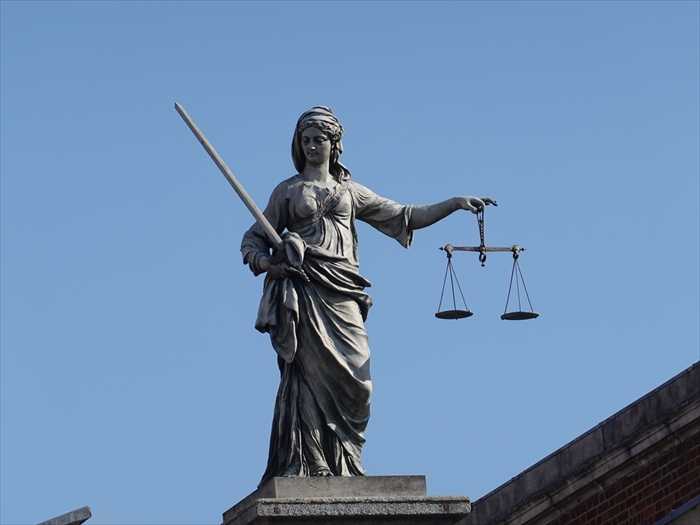
ダブリン城の「 Upper Yard(上の中庭) 」にある門の上に設置されている
この像は、 勇気(Fortitude)または武勇(Valour)を象徴する寓意像(アレゴリカル・
スタチュー)。
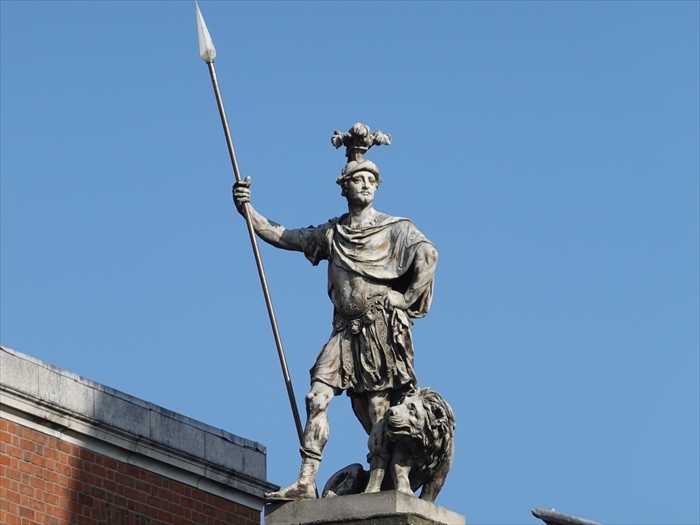
時計塔(Clock Tower) のクローズアップ。
Upper Yard(アッパー・ヤード/上の中庭)の北側中央に位置する建物の上部。
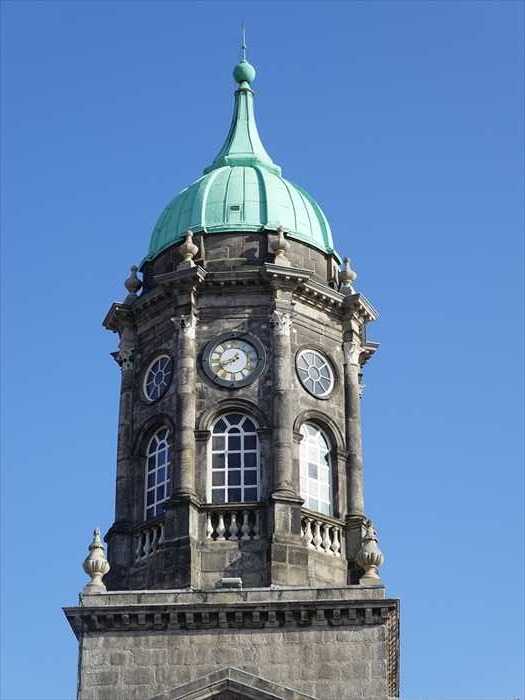
/Cork Hill Gate 」の上に設置されていた「 正義の女神(Lady Justice) 」を再び。

ダブリン城の「 Upper Yard(上の中庭) 」にある門の上に設置されている
この像は、 勇気(Fortitude)または武勇(Valour)を象徴する寓意像(アレゴリカル・
スタチュー)。

時計塔(Clock Tower) のクローズアップ。
Upper Yard(アッパー・ヤード/上の中庭)の北側中央に位置する建物の上部。

中世のダブリン城(Medieval Dublin Castle)
に関する解説パネル。
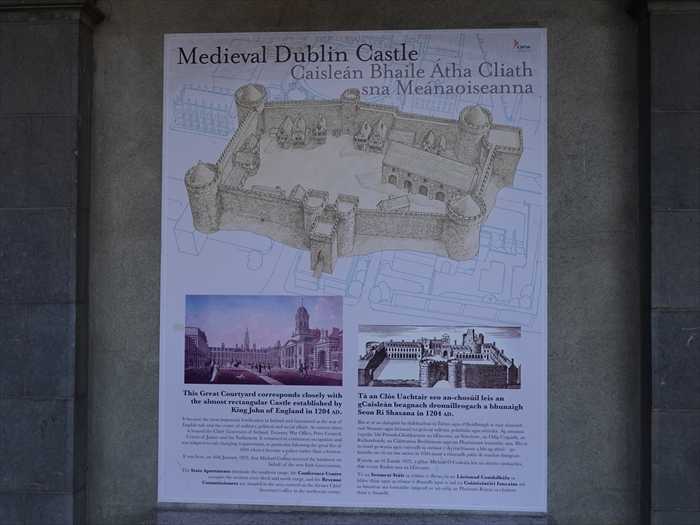
Medieval Dublin Castle
Caisleán Bhaile Átha Cliath sna Meánaoiseanna

「 This Great Courtyard corresponds closely with the almost rectangular Castle
established by King John of England in 1204 AD.
It became the most important fortification in Ireland and functioned as the seat of
English rule and the centre of military, political and social affairs. At various times
it housed the Chief Governors of Ireland, Treasury, War Office, Privy Council,
Courts of Justice and the Parliament. It remained in continuous occupation and was
adapted to suit changing requirements, in particular following the great fire of 1684
when it became a palace rather than a fortress.
It was here, on 16th January 1922, that Michael Collins received the handover
on behalf of the new Irish Government.」
【 中世のダブリン城
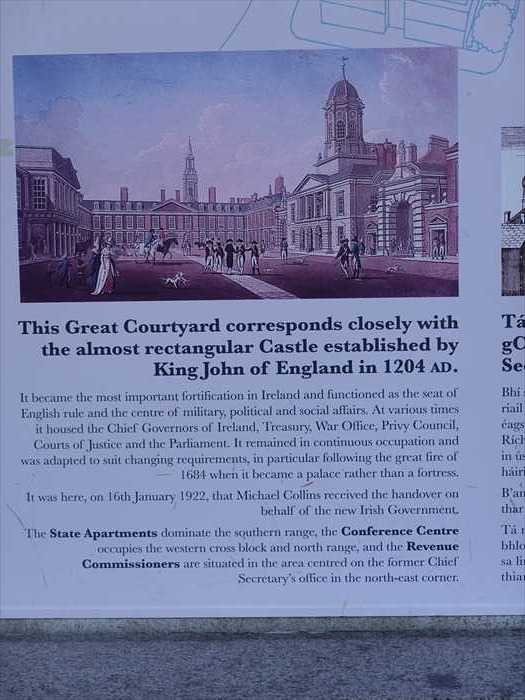
「グレート・コートヤード(Great Courtyard)」 を東側から。



ダブリン城(Dublin Castle)の外壁に設置された案内パネルの一部で、中央右側に見えるのが
「 レコード・タワー(Record Tower) 」

「The Record Tower is one of the oldest surviving parts of Dublin Castle, and one of the
oldest buildings in the city of Dublin.
It was constructed between and 1228 and was the largest of four round towers that
formed the corners of the medieval castle of Dublin. Over the centuries, two of these
towers disappeared entirely while a third, the Bermingham Tower, was rebuilt
in the 1770s andcan be seen from the Castle’s Dubh Linn Gardens today.
During its 800 years, the Record Tower served as a medieval wardrobe, where garments
and other precious items were stored. It became a prison in the late 1500s and remained
in use until the 1700s. The upper rooms were refurbished for the storage of public records,
giving the tower its name. The base of the tower housed prisoners awaiting execution,
including notable Irish rebels Henry and John Sheares in 1798 and Robert Emmet in 1803.
Between 1811 and 1813, an extra floor was added to the Tower and it was turned into a repository for important state papers and documents. It was at this time that it became
known as the 'Record Tower'. It continued to fulfil this purpose up until the early 1990s,
when the records were moved to the National Archives of Ireland.
In conjunction with Fáilte Ireland, the Office of Public Works has embarked on a major
project of conservation and redevelopment of the Record Tower. This building has stood
as silent witness to the nation's history for 800 years, as it unfolded in and around the
historic complex of Dublin Castle. It will soon reopen to the public and its fascinating
stories told once more.」
【 レコード・タワー(記録の塔)は、ダブリン城に現存する最古の部分の一つであり、
ダブリン市内でも最も古い建物の一つです。
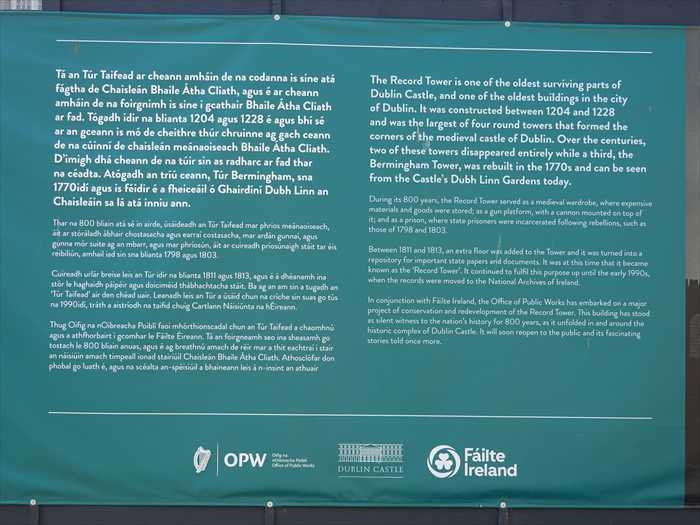
チャペル・ロイヤル(Chapel Royal)の側面(北面または西面) を捉えたもの。
背景右奥には レコード・タワー(Record Tower)の一部 も見えていた。
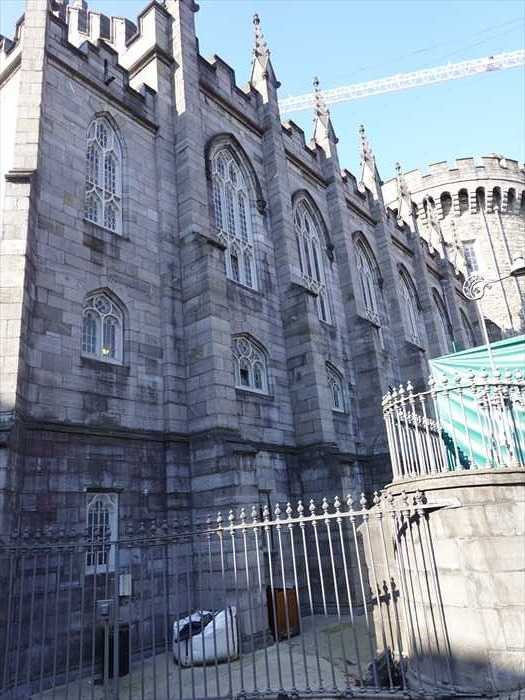
「 The Chapel Royal
was the Bishop of Tuam, John Orr, in 1922, just before the Lord Lieutenant of Ireland left.」
【 チャペル・ロイヤル
トゥアム司教ジョン・オールで、彼が説教したのは1922年、アイルランド総督が退任する直前の
ことでした。】
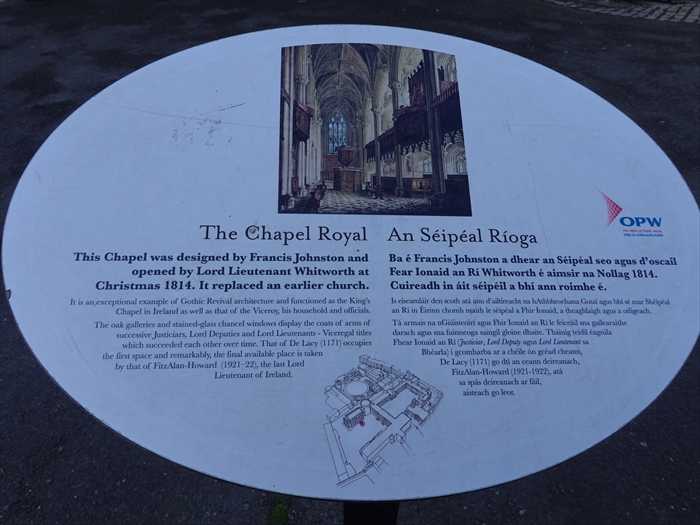
「 チャペル・ロイヤル(Chapel Royal) 」の正面(西面)入口。

Medieval Dublin Castle
Caisleán Bhaile Átha Cliath sna Meánaoiseanna

「 This Great Courtyard corresponds closely with the almost rectangular Castle
established by King John of England in 1204 AD.
It became the most important fortification in Ireland and functioned as the seat of
English rule and the centre of military, political and social affairs. At various times
it housed the Chief Governors of Ireland, Treasury, War Office, Privy Council,
Courts of Justice and the Parliament. It remained in continuous occupation and was
adapted to suit changing requirements, in particular following the great fire of 1684
when it became a palace rather than a fortress.
It was here, on 16th January 1922, that Michael Collins received the handover
on behalf of the new Irish Government.」
【 中世のダブリン城
(アイルランド語:Caisleán Bhaile Átha Cliath sna Meánaoiseanna)
この「グレート・コートヤード(大中庭)」は、1204年にイングランド王ジョンによって
築かれたほぼ長方形の城郭とよく一致しています。
築かれたほぼ長方形の城郭とよく一致しています。
この場所は、アイルランドで最も重要な防衛施設となり、イングランド統治の本拠地として
機能しました。また、軍事・政治・社会活動の中心地でもありました。
機能しました。また、軍事・政治・社会活動の中心地でもありました。
さまざまな時期に、アイルランド総督、財務省、陸軍省、枢密院、裁判所、議会がここに
置かれました。
置かれました。
この城は長年にわたり使用され続け、特に1684年の大火の後は、要塞ではなく宮殿として
改修されていきました。
改修されていきました。
ここで1922年1月16日、マイケル・コリンズが新しいアイルランド政府を代表して城の
引き渡しを受けました。
引き渡しを受けました。
ステート・アパートメント(State Apartments)は南側の建物群を占め、カンファレンス・
センター(Conference Centre)は西側の横棟および北側の棟を、税務署
(Revenue Commissioners)は北東隅にある旧アイルランド官房長官室の周辺に配置
されています。】
センター(Conference Centre)は西側の横棟および北側の棟を、税務署
(Revenue Commissioners)は北東隅にある旧アイルランド官房長官室の周辺に配置
されています。】

「グレート・コートヤード(Great Courtyard)」 を東側から。

左側のゴシック建築:チャペル・ロイヤル(Chapel Royal)
・19世紀初頭(1807〜1814年)に建設されたゴシック・リヴァイヴァル様式の礼拝堂。
・英国支配時代、アイルランド副王や英国王族の礼拝所として使われました。
・建物の外観は、尖塔型の装飾やランセット窓(尖りアーチ窓)などが特徴。
現在では展示・コンサート・ガイドツアーの場として使用されることもあります。
右側の円塔:レコード・タワー(Record Tower)
・13世紀のオリジナルの防御塔で、現存する唯一の中世部分。
・ダブリン城がもともと要塞(fortress)だった頃の面影を残す構造。
・厚い石壁と小窓、防御用の城壁構造を備えています。
名の通り、かつては重要文書の保管所(記録保管塔)として使用されていました。

レコード・タワー(Record Tower)
・建設年代:1204年以降、13世紀初頭
・建築様式:ノルマン様式(円形石造塔、防御構造)
・特徴:
・厚い石壁とわずかな小窓(攻撃に備えた設計)
・上部にある櫓(マシュキュレーション風の装飾)は、矢や石を落とす防御構造の名残を
模している
模している
・現在も原形を保つ、ダブリン城で唯一残る中世要塞部分

ダブリン城(Dublin Castle)の外壁に設置された案内パネルの一部で、中央右側に見えるのが
「 レコード・タワー(Record Tower) 」

「The Record Tower is one of the oldest surviving parts of Dublin Castle, and one of the
oldest buildings in the city of Dublin.
It was constructed between and 1228 and was the largest of four round towers that
formed the corners of the medieval castle of Dublin. Over the centuries, two of these
towers disappeared entirely while a third, the Bermingham Tower, was rebuilt
in the 1770s andcan be seen from the Castle’s Dubh Linn Gardens today.
During its 800 years, the Record Tower served as a medieval wardrobe, where garments
and other precious items were stored. It became a prison in the late 1500s and remained
in use until the 1700s. The upper rooms were refurbished for the storage of public records,
giving the tower its name. The base of the tower housed prisoners awaiting execution,
including notable Irish rebels Henry and John Sheares in 1798 and Robert Emmet in 1803.
Between 1811 and 1813, an extra floor was added to the Tower and it was turned into a repository for important state papers and documents. It was at this time that it became
known as the 'Record Tower'. It continued to fulfil this purpose up until the early 1990s,
when the records were moved to the National Archives of Ireland.
In conjunction with Fáilte Ireland, the Office of Public Works has embarked on a major
project of conservation and redevelopment of the Record Tower. This building has stood
as silent witness to the nation's history for 800 years, as it unfolded in and around the
historic complex of Dublin Castle. It will soon reopen to the public and its fascinating
stories told once more.」
【 レコード・タワー(記録の塔)は、ダブリン城に現存する最古の部分の一つであり、
ダブリン市内でも最も古い建物の一つです。
この塔は、1204年から1228年の間に建設され、ダブリンの中世の城を形作っていた四隅の
円塔の中で最大のものでした。
円塔の中で最大のものでした。
数世紀のうちに、これら四つの塔のうち二つは完全に失われ、三つ目の塔であるバーミンガム・
タワーは1770年代に再建され、現在もダブリン城のダブリン庭園(Dubh Linn Gardens)から
その姿を望むことができます。
タワーは1770年代に再建され、現在もダブリン城のダブリン庭園(Dubh Linn Gardens)から
その姿を望むことができます。
800年の歴史の中で、レコード・タワーはかつて中世の「ワードローブ(衣装部屋)」として
使われ、衣類や貴重品の保管場所とされていました。
使われ、衣類や貴重品の保管場所とされていました。
16世紀後半には牢獄として利用されるようになり、18世紀までその用途が続きました。
その後、塔の上層部は公文書の保管のために改装され、これにより塔は「レコード・タワー
(記録の塔)」と呼ばれるようになります。
(記録の塔)」と呼ばれるようになります。
塔の下層部分には、死刑を待つ囚人たちが収容されており、中には1798年の反乱に関与した
ヘンリーとジョン・シアーズ兄弟や、1803年の反乱指導者ロバート・エメットといった著名な
アイルランド人反逆者たちも含まれていました。
ヘンリーとジョン・シアーズ兄弟や、1803年の反乱指導者ロバート・エメットといった著名な
アイルランド人反逆者たちも含まれていました。
1811年から1813年にかけて、塔にはもう一階が増築され、国家の重要な文書や記録の保管庫
へと改修されました。
へと改修されました。
この時期に正式に「レコード・タワー」と呼ばれるようになり、1990年代初頭までその役割を
果たしていました。
果たしていました。
その後、保管されていた記録はアイルランド国立公文書館へと移されました。
現在、Fáilte Ireland(フォールチャ・アイルランド)との協力のもと、公共事業局
(Office of Public Works)は、この塔の保存と再開発のための大規模プロジェクトに
着手しています。
(Office of Public Works)は、この塔の保存と再開発のための大規模プロジェクトに
着手しています。
この建物は、800年にわたり、ダブリン城という歴史的複合施設の中で展開されてきた
アイルランドの歴史を静かに見守ってきた証人であり、
間もなく再び一般公開され、その魅力的な物語が人々に語られることでしょう。】アイルランドの歴史を静かに見守ってきた証人であり、

チャペル・ロイヤル(Chapel Royal)の側面(北面または西面) を捉えたもの。
背景右奥には レコード・タワー(Record Tower)の一部 も見えていた。

「 The Chapel Royal
This Chapel was designed by Francis Johnston and opened by Lord Lieutenant Whitworth
at Christmas 1814. It replaced an earlier church.
at Christmas 1814. It replaced an earlier church.
It is an exceptional example of Gothic Revival architecture and functioned as the King's
Chapel in Ireland as well as that of the Viceroy, his household and staff.
Chapel in Ireland as well as that of the Viceroy, his household and staff.
The oak galleries and stained-glass chancel windows display the coats of arms of
successive Lord Lieutenants and senior Dublin Castle officials, which were painted/carved
either during their terms of office or afterwards.
The first guest preacher was Thomas Lewis O'Beirne, the Bishop of Meath, and the lastsuccessive Lord Lieutenants and senior Dublin Castle officials, which were painted/carved
either during their terms of office or afterwards.
was the Bishop of Tuam, John Orr, in 1922, just before the Lord Lieutenant of Ireland left.」
【 チャペル・ロイヤル
この礼拝堂はフランシス・ジョンストンによって設計され、1814年のクリスマスに
総督ホイットワース卿によって開かれました。
総督ホイットワース卿によって開かれました。
それ以前の教会に代わるものでした。
この建物はゴシック・リヴァイヴァル建築の傑出した例であり、アイルランドにおける国王の
礼拝堂として、また総督とその家族や職員の礼拝堂として機能していました。
礼拝堂として、また総督とその家族や職員の礼拝堂として機能していました。
オーク材のギャラリー(回廊)やステンドグラスの内陣窓には、代々のアイルランド総督や
ダブリン城の高官たちの紋章が描かれ/彫刻されています。これらは彼らの在任中または
退任後に設置されました。
最初のゲスト説教者は ミーズ司教トマス・ルイス・オバーンであり、最後の説教者はダブリン城の高官たちの紋章が描かれ/彫刻されています。これらは彼らの在任中または
退任後に設置されました。
トゥアム司教ジョン・オールで、彼が説教したのは1922年、アイルランド総督が退任する直前の
ことでした。】

「 チャペル・ロイヤル(Chapel Royal) 」の正面(西面)入口。
建物名:Chapel Royal(王室礼拝堂)
竣工年:1814年(クリスマスに落成)
設計者:フランシス・ジョンストン(Francis Johnston)
建築様式:ゴシック・リヴァイヴァル様式(Gothic Revival)
用途:英国統治下におけるアイルランド総督とその家族・職員のための礼拝堂。
上部に 城郭風のギザギザ(=クレネレーション) が施されており、防御的な中世の城を模した
デザイン。
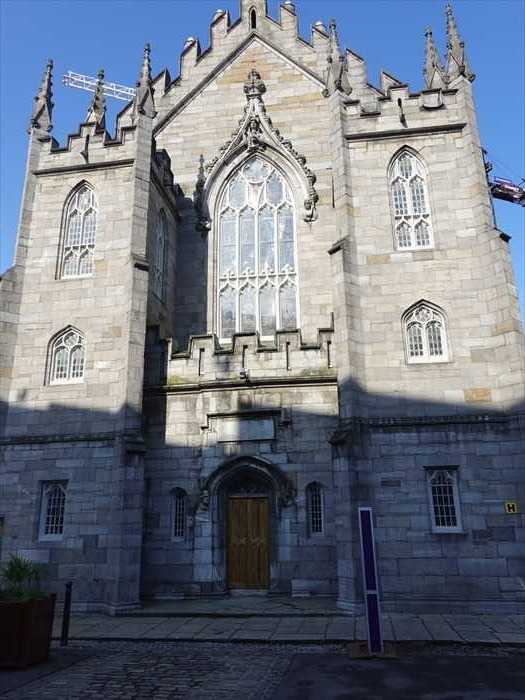
「チャペル・ロイヤル(Chapel Royal)」の南面。
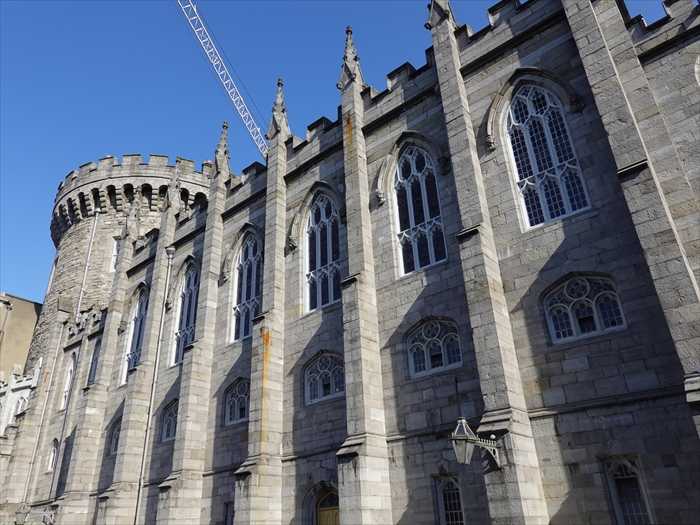
ダブリン城(Dublin Castle)の西面を南西方向から。
写真中央から左へ

ダブリン城(Dublin Castle)の構内案内バナー。
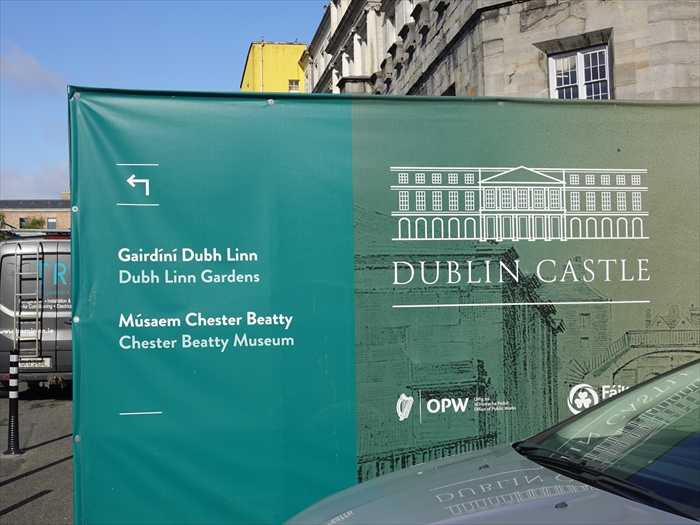
ダブリン城敷地内で開催されている 展覧会の案内看板
上部に 城郭風のギザギザ(=クレネレーション) が施されており、防御的な中世の城を模した
デザイン。

「チャペル・ロイヤル(Chapel Royal)」の南面。
左端:
レコード・タワー(1204〜1228年築)
中央〜右:
チャペル・ロイヤル(1814年完成)
この南面はダブリン城の「中庭(Upper Yard)」側に面していた。
この南面はダブリン城の「中庭(Upper Yard)」側に面していた。

ダブリン城(Dublin Castle)の西面を南西方向から。
写真中央から左へ
レコード・タワー(Record Tower)
1204〜1228年頃に建てられた、ダブリン城に現存する最古の部分。中世の円形防御塔で、
19世紀には記録文書保管庫に転用され「Record Tower」と呼ばれるようになりました。
19世紀には記録文書保管庫に転用され「Record Tower」と呼ばれるようになりました。
チャペル・ロイヤル(Chapel Royal)
ネオ・ゴシック様式で1814年に完成した礼拝堂。レコード・タワーの右隣に連なる尖塔のある」
壁面群がそれにあたります。
壁面群がそれにあたります。
上級裁判所棟(Upper Castle Yardの北西翼)
レコード・タワーに接続する形で左側に見える古典主義的ファサードの建物。18世紀以降の
再建で、国家の行政機能を担ってきました。
再建で、国家の行政機能を担ってきました。

ダブリン城(Dublin Castle)の構内案内バナー。
Gairdíní Dubh Linn
Dubh Linn Gardensダブ・リン庭園
(Dubh Linn ガーデンズ)
Músaem Chester Beatty
Chester Beatty Museumチェスター・ビーティー図書館・美術館

ダブリン城敷地内で開催されている 展覧会の案内看板
「The Fine Art of Textile
Contemporary artists explore the expressive potential of an ancient art form
Fringe Collective & Guests
&
The Wild Donegal Tweed Project
Curated by Judith Cunningham
FRINGE COLLECTIVE:
Amanda Jane Graham ・ Bernie Leahy ・ Carmel Brennan ・ Jennifer Trouton ・ Sandra Deery
GUEST ARTISTS:
Alice Maher ・ Michael Cullen ・ Orla Kaminska ・ Paula Stokes ・ Shani Rhys James
06.06.2025 – 24.08.2025
Chapel Royal, Dublin Castle
Monday to Saturday: 10am – 5pm
Sunday & Bank Holidays: 1pm – 5pm
Last entry: 4:45pm
Free Admission」
【 テキスタイルの美術
【 テキスタイルの美術
— 現代アーティストが、古来の芸術形式の表現的な可能性を探る —
フリンジ・コレクティブ & 招待作家たち
&
ワイルド・ドニゴール・ツイード・プロジェクト
キュレーター:ジュディス・カニンガム
フリンジ・コレクティブの作家
アマンダ・ジェーン・グラハム
バーニー・リーヒー
カーメル・ブレナン
ジェニファー・トラウトン
サンドラ・ディーリー
招待作家
アリス・マハー
マイケル・カレン
オルラ・カミンスカ
ポーラ・ストークス
シャーニ・リース・ジェームズ
会期: 2025年6月6日~8月24日
会場: ダブリン城 チャペル・ロイヤル
・月〜土曜:午前10時〜午後5時
・日曜・祝日:午後1時〜午後5時
・最終入場:午後4時45分
お気に入りの記事を「いいね!」で応援しよう
【毎日開催】
15記事にいいね!で1ポイント
10秒滞在
いいね!
--
/
--
© Rakuten Group, Inc.











